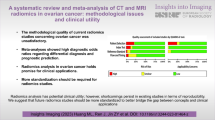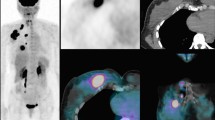Abstract
Purpose
To perform a rapid review of the recent literature on radiomics and breast cancer (BC).
Methods
A rapid review, a streamlined approach to systematically identify and summarize emerging studies was done (updated 27 September 2017). Clinical studies eligible for inclusion were those that evaluated BC using a radiomics approach and provided data on BC diagnosis (detection or characterization) or BC prognosis (response to therapy, morbidity, mortality), or provided data on technical challenges (software application: open source, repeatability of results). Descriptive statistics, results, and radiomics quality score (RQS) are presented.
Results
N = 17 retrospective studies, all published after 2015, provided BC-related radiomics data on 3928 patients evaluated with a radiomics approach. Most studies were done for diagnosis and/or characterization (65%, 11/17) or to aid in prognosis (41%, 7/17). The mean number of radiomics features considered was 100. Mean RQS score was 11.88 ± 5.8 (maximum value 36). The RQS criteria related to validation, gold standard, potential clinical utility, cost analysis, and open science data had the lowest scores. The majority of studies n = 16/17 (94%) provided correlation with histological outcomes and staging variables or biomarkers. Only 4/17 (23%) studies provided evidence of correlation with genomic data. Magnetic resonance imaging (MRI) was used in most studies n = 14/17 (82%); however, ultrasound (US), mammography, or positron emission tomography with 2-deoxy-2-[fluorine-18]fluoro-d-glucose integrated with computed tomography (18F FDG PET/CT) was also used. Much heterogeneity was found for software usage.
Conclusions
The study of radiomics in BC patients is a new and emerging translational research topic. Radiomics in BC is frequently done to potentially improve diagnosis and characterization, mostly using MRI. Substantial quality limitations were found; high-quality prospective and reproducible studies are needed to further potential application.
Similar content being viewed by others
Abbreviations
- BC:
-
Breast cancer
- RQS:
-
Radiomics quality score
- MRI:
-
Magnetic resonance imaging
- US:
-
Ultrasound
- 18F FDG PET/CT:
-
Positron emission tomography with 2-deoxy-2-[fluorine-18]fluoro-d-glucose integrated with computed tomography
- CT:
-
Computed tomography
- PET:
-
Positron emission tomography
- CT/PET:
-
Computed tomography integrated with positron emission tomography
- LABC:
-
Locally advanced breast cancer
- NAC:
-
Neoadjuvant chemotherapy
- TCGA:
-
The cancer genome atlas
- TCIA:
-
The cancer imaging archive
- ER:
-
Estrogen receptor
- PR:
-
Progesterone receptor
- HER2:
-
Human epidermal growth factor receptor 2
- BPE:
-
Background parenchymal enhancement
- DCE-MRI:
-
Dynamic contrast-enhanced magnetic resonance imaging
- SLN:
-
Sentinel lymph node
- pCR:
-
Pathological complete response
- ADC:
-
Apparent diffusion coefficient
- CoLlAGe:
-
Co-occurrence of local anisotropic gradient orientations
- PAM50:
-
Prediction analysis of microarray 50
References
Ferlay J, Steliarova-Foucher E, Lortet-Tieulent J, Rosso S, Coebergh JW, Comber H, Forman D, Bray F (2013) Cancer incidence and mortality patterns in Europe: estimates for 40 countries in 2012. Eur J Cancer 49:1374–1403. https://doi.org/10.1016/j.ejca.2012.12.027
Bland KI (2017) The breast: comprehensive management of benign and malignant disease. Saunders, Philadelphia
Lambin P, Rios-Velazquez E, Leijenaar R, Carvalho S, Stiphout RV, Granton P et al (2012) Radiomics: extracting more information from medical images using advance feature analysis. Eur J Cancer 48:441–446
Li H, Zhu Y, Burnside ES, Huang E, Drukker K, Hoadley KA et al (2016) Quantitative MRI radiomics in the prediction of molecular classifications of breast cancer subtypes in the TCGA/TCIA data set. NPJ Breast Cancer 2:16012
Aerts HJ, Velazquez ER, Leijenaar RT et al (2014) Decoding tumour phenotype by noninvasive imaging using a quantitative radiomics approach. Nat Commun 5:4006
Limkin EJ, Sun R, Dercle L, Zacharaki EI, Robert C et al (2017) Promises and challenges for the implementation of computational medical imaging (radiomics) in oncology. Ann Oncol 28:1191–1206. https://doi.org/10.1093/annonc/mdx034
Khangura S, Konnyu K, Cushman R, Grimshaw J, Moher D (2012) Evidence summaries: the evolution of a rapid review approach. Syst Rev 1:10
Gillies RJ, Kinahan PE, Hricak H (2016) Radiomics: images are more than pictures, they are data. Radiology 278:563–577. https://doi.org/10.1148/radiol.2015151169
Lambin P, Leijenaar RTH, Deist TM, Peerlings J, De Jong EEC, van Timmeren J et al (2017) Radiomics: the bridge between medical imaging and personalized medicine. Nat Rev Clin Oncol. https://doi.org/10.1038/nrclinonc.2017.141
Guo Y, Hu Y, Qiao M, Wang Y, Yu J, Li J, Chang C (2017) Radiomics analysis on ultrasound for prediction of biologic behavior in breast invasive ductal carcinoma. Clin Breast Cancer. https://doi.org/10.1016/j.clbc.2017.08.002
Dong Y, Feng Q, Yang W, Lu Z, Deng C, Zhang L, Lian Z, Liu J, Luo X, Pei S, Mo X, Huang W, Liang C, Zhang B, Zhang S (2017) Preoperative prediction of sentinel lymph node metastasis in breast cancer based on radiomics of T2-weighted fat-suppression and diffusion-weighted MRI. Eur Radiol. https://doi.org/10.1007/s00330-017-5005-7
Antunovic L, Gallivanone F, Sollini M, Sagona A, Invento A, Manfrinato G, Kirienko M, Tinterri C, Chiti A, Castiglioni I (2017) [18F]FDG PET/CT features for the molecular characterization of primary breast tumors. Eur J Nucl Med Mol Imaging. https://doi.org/10.1007/s00259-017-3770-9
Antropova N, Huynh BQ, Giger ML (2017) A deep feature fusion methodology for breast cancer diagnosis demonstrated on three imaging modality datasets. Med Phys. https://doi.org/10.1002/mp.12453
Chan HM, van der Velden BHM, Loo CE, Gilhuijs KGA (2017) Eigentumors for prediction of treatment failure in patients with early-stage breast cancer using dynamic contrast-enhanced MRI: a feasibility study. Phys Med Biol 62:6467–6485. https://doi.org/10.1088/1361-6560/aa7dc5
Braman NM, Etesami M, Prasanna P, Dubchuk C, Gilmore H, Tiwari P, Plecha D, Madabhushi A (2017) Intratumoral and peritumoral radiomics for the pretreatment prediction of pathological complete response to neoadjuvant chemotherapy based on breast DCE-MRI. Breast Cancer Res 18(19):57. https://doi.org/10.1186/s13058-017-0846-1
Ha S, Park S, Bang JI, Kim EK, Lee HY (2017) Metabolic radiomics for pretreatment 18F-FDG PET/CT to characterize locally advanced breast cancer: histopathologic characteristics, response to neoadjuvant chemotherapy, and prognosis. Sci Rep 7:1556. https://doi.org/10.1038/s41598-017-01524-7
Bickelhaupt S, Paech D, Kickingereder P, Steudle Lederer W, Daniel H, Götz M, Gählert N, Tichy D, Wiesenfarth M, Laun FB, Maier-Hein KH, Schlemmer HP, Bonekamp D (2017) Prediction of malignancy by a radiomic signature from contrast agent-free diffusion MRI in suspicious breast lesions found on screening mammography. J Magn Reson Imaging 46:604–616. https://doi.org/10.1002/jmri.25606
Prasanna Prateek, Tiwari Pallavi, Madabhushi Anant (2016) Co-occurrence of local anisotropic gradient orientations (CoLlAGe): a new radiomics descriptor. Sci Rep 6:37241. https://doi.org/10.1038/srep37241
Li H, Zhu Y, Burnside ES, Drukker K, Hoadley KA, Fan C, Conzen SD, Whitman GJ, Sutton EJ, Net JM, Ganott M, Huang E, Morris EA, Perou CM, Ji Y, Giger ML (2016) MR imaging radiomics signatures for predicting the risk of breast cancer recurrence as given by research versions of MammaPrint, Oncotype DX, and PAM50 gene assays. Radiology 281:382–391
Obeid JP, Stoyanova R, Kwon D, Patel M, Padgett K, Slingerland J, Takita C, Alperin N, Yepes M (2017) Zeidan YH (2017) Multiparametric evaluation of preoperative MRI in early stage breast cancer: prognostic impact of peri-tumoral fat. Clin Transl Oncol 19:211–218. https://doi.org/10.1007/s12094-016-1526-9
Fan M, Wu G, Cheng H, Zhang J, Shao G, Li L (2017) Radiomic analysis of DCE-MRI for prediction of response to neoadjuvant chemotherapy in breast cancer patients. Eur J Radiol 94:140–147. https://doi.org/10.1016/j.ejrad.2017.06.019
Fan M, Li H, Wang S, Zheng B, Zhang J, Li L (2017) Radiomic analysis reveals DCE-MRI features for prediction of molecular subtypes of breast cancer. PLoS ONE 12(2):e0171683. https://doi.org/10.1371/journal.pone.0171683
Zhu Y, Li H, Guo W, Drukker K, Lan L, Giger ML, Ji Y (2015) Deciphering genomic underpinnings of quantitative MRI-based radiomic phenotypes of invasive breast carcinoma. Sci Rep 7(5):17787. https://doi.org/10.1038/srep17787
Guo W, Li H, Zhu Y, Lan L, Yang S, Drukker K, Morris E, Burnside E, Whitman G, Giger ML, Ji Y, Tcga Breast Phenotype Research Group8 (2015) Prediction of clinical phenotypes in invasive breast carcinomas from the integration of radiomics and genomics data. J Med Imaging. 2:041007. https://doi.org/10.1117/1.jmi.2.4.041007
Wang J, Kato F, Oyama-Manabe N, Li R, Cui Y, Tha KK, Yamashita H, Kudo K, Shirato H (2015) Identifying triple-negative breast cancer using background parenchymal enhancement heterogeneity on dynamic contrast-enhanced MRI: a pilot radiomics study. PLoS ONE 10(11):e0143308. https://doi.org/10.1371/journal.pone.0143308
Braman NM, Etesami M, Prasanna P, Dubchuk C, Gilmore H, Tiwari P, Plecha D, Madabhushi A (2017) Erratum to: intratumoral and peritumoral radiomics for the pretreatment prediction of pathological complete response to neoadjuvant chemotherapy based on breast DCE-MRI. Breast Cancer Res 19(1):80. https://doi.org/10.1186/s13058-017-0862-1
Marin Z, Batchelder KA, Toner BC, Guimond L, Gerasimova-Chechkina E, Harrow AR, Arneodo A, Khalil A (2017) Mammographic evidence of microenvironment changes in tumorous breasts. Med Phys 44:1324–1336. https://doi.org/10.1002/mp.12120
Parekh V, Jacobs MA (2016) Radiomics: a new application from established techniques. Expert Rev Precis Med Drug Dev 1:207–226. https://doi.org/10.1080/23808993.2016.1164013
Shannon CE (1948) A mathematical theory of communication. Bell Syst Tech J 27(3):379–423
Haralick RM, Shanmugam K, Dinstein IH (1973) Textural features for image classification. IEEE Trans Syst Man Cybern 6:610–621
Galloway MM (1975) Texture analysis using gray level run lengths. Comput Graph Image Process 4:172–179
Napel S, Giger M (2015) Radiomics and imaging genomics: quantitative imaging for precision medicine. J Med Imaging 2:041001. https://doi.org/10.1117/1.JMI.2.4.041001
Jaffe C (2012) Imaging and genomics: is there a synergy? Radiology 264:329–331
http://www.radiomics.world/. Accessed 18 May 2017
Collins G, Reitsma J, Altman D et al (2015) Transparent reporting of a multivariable prediction model for individual prognosis or diagnosis (TRIPOD): the TRIPOD Statement. Ann Intern Med 162:55–63
Houssami N, Lee CI, Buist DSM, Tao D (2017) Artificial intelligence for breast cancer screening: opportunity or hype? Breast 36:31–33. https://doi.org/10.1016/j.breast.2017.09.003
Parekh VS, Jacobs MA (2017) Integrated radiomic framework for breast cancer and tumor biology using advanced machine learning and multiparametric MRI. NPJ Breast Cancer 3:43. https://doi.org/10.1038/s41523-017-0045-3
Papp L, Poetsch N, Grahovac M et al (2017) Glioma survival prediction with the combined analysis of in vivo 11C-MET-PET, ex vivo and patient features by supervised machine learning. J Nucl Med. https://doi.org/10.2967/jnumed.117.202267
Garapati SS, Hadjiiski L, Cha KH et al (2017) Urinary bladder cancer staging in CT urography using machine learning. Med Phys 44:5814–5823. https://doi.org/10.1002/mp.12510
Zhang B, He X, Ouyang F et al (2017) Radiomic machine-learning classifiers for prognostic biomarkers of advanced nasopharyngeal carcinoma. Cancer Lett 403:21–27. https://doi.org/10.1016/j.canlet.2017.06.004
Rahbar H, McDonald ES, Lee JM, Partridge SC, Lee CI (2016) How can advanced imaging be used to mitigate potential breast cancer overdiagnosis? Acad Radiol. 23:768–773. https://doi.org/10.1016/j.acra.2016.02.008
Funding
Alberto Stefano Tagliafico received funding under grants: AIRC Associazione Italiana Ricerca sul Cancro IG 15697. N. Houssami received research support through a National Breast Cancer Foundation (NBCF Australia), Breast Cancer Research Leadership Fellowship.
Author information
Authors and Affiliations
Corresponding author
Ethics declarations
Conflict of interest
The authors declare that they have no conflict of interest.
Electronic supplementary material
Below is the link to the electronic supplementary material.
Rights and permissions
About this article
Cite this article
Valdora, F., Houssami, N., Rossi, F. et al. Rapid review: radiomics and breast cancer. Breast Cancer Res Treat 169, 217–229 (2018). https://doi.org/10.1007/s10549-018-4675-4
Received:
Accepted:
Published:
Issue Date:
DOI: https://doi.org/10.1007/s10549-018-4675-4




